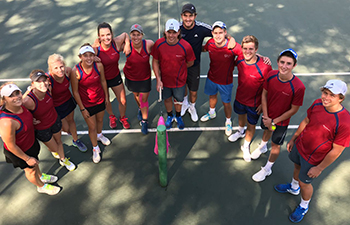
The first and second tennis teams of the University of the
Free State were first and fifth respectively among the 14
teams competing in the Egalite Invitational challenge.
Photo: Arne Nel
Although a tournament victory was not the Kovsie tennis team’s main goal, they still managed to outplay the best in the country.
The first team of the University of the Free State (UFS), who have been the champions of the combined USSA format for the past six years, successfully defended its title to end the Egalite Invitational challenge in Sun City unbeaten.
Second team also performing well
On 26 March 2017, the Kovsie first team defeated Puk’s first team 35-20 (games) in the final. Their second team also performed well and won against Tuks’ second team 31-21 to end fifth among the 14 teams. The matches in the tournament, which took place from 24 to 26 March 2017, were played in World Team Tennis format.
In the group stages, the Kovsie first team beat Puk’s second (35-12), Puk’s fourth (35-8), Tuks’ second (35-12), Maties’ first (31-19), Puk’s sixth (35-5), and Tuks’ third (32-16) teams. The team consists of Arne Nel, Christo Koekemoer, Emke Kruger, Lienke de Kock, Ansunica Brits, and Reze Opperman.
Preparation for USSA
Apart from USSA, the Sun City tournament is the other major tournament in which the UFS annually competes. “Of course you want to win, but unlike at USSA, this was not our main focus in Sun City,” says Janine de Kock, the Kovsie team manager. “We wanted to try new combinations and provide exposure to new players.”
A total of five of the 12 players in the two teams were newcomers. They are Lienke de Kock (first team), Handré Hoffman, JC Conradie, Brieta Pienaar, and Daniel de Villiers (all second team). According to Janine de Kock, it was especially important to test new doubles combinations before USSA.
“We always knew the first team is a good team with a chance, but we are very impressed with the second team’s fifth place.”